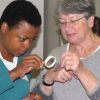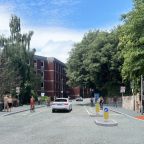
Celebrating Exeter’s multicultural history
The education charity behind a ground-breaking multicultural history project in Exeter believes it will have a lasting legacy in the city – and says it should be rolled out at other cities across the country.
The Heritage Lottery-funded Telling Our Stories, Finding Our Roots (TOSFOR) project officially ended on 20 December but volunteers will continue to maintain the website and work with local primary and secondary schools. The charity, Devon Development Education, is also hoping that the public will carry on submitting stories to the website about people and places from Exeter’s multicultural past.
The community project has been widely praised for helping to raise awareness of Exeter’s diversity down the centuries. Some 2,800 people have had a direct connection to TOSFOR and project leader Ghee Bowman believes it could have a similar impact in other cities.
“This project is replicable elsewhere in the country, in other provincial cities and even in places with an entirely different profile, such as Leicester or the East End of London,” said Ghee. “The idea of building a team of community researchers to dig out these stories and for them to be told on a community website and via the medium of story-telling is one that would do really well in many places across the UK.”
TOSFOR Exeter is thought to be the most comprehensive local history project of its kind nationally. The driving force behind the 15-month project was a team of 22 local residents whose backgrounds are diverse but whose stories have all converged in Exeter. Over half of the project team are from Exeter’s Black and Minority Ethnic community.
After being taught research skills, they set about collecting stories dating back 2,000 years, which together paint a picture of Exeter’s multicultural past – and present.
The stories are included on a website tellingourstoriesexeter.org.uk, together with downloadable resources for schools to use. And although the funding period has ended, the story timeline on the website will grow and grow as more tales are uncovered.
The stories include the role of Black GIs who were based in Exeter during the war. The researcher for this was volunteer Crystal Carter, originally from California but a resident of Exeter since 2005. Crystal’s father and grandfather were black servicemen in the US military, her grandfather serving during World War Two.
The tale of how a statue of the Hindu God Ganesh ended up at Exeter’s Royal Albert Memorial Museum (RAMM) is also told by volunteer researcher Sandhya Dave, a second generation British-born Gujarati Indian.
Sandhya also did a bit of digging into the site that now houses the Pizza Hut restaurant in the St Thomas area of Exeter, but which was formerly a foundry dating back to the 1500s. It made manillas – bronze bracelets that were used for trading, especially in West Africa – and would have been traded for slaves.
It is believed that the foundry is probably the oldest one in Britain that was making manillas – so Devon might possibly have had earlier trade links with Africa than anywhere else.
Ghee says the website will continue to have an impact: “It’s a rich resource and we really want the city’s schools to take it up, too. We’ve got dates with five schools for next term, and are looking for more. We’re aiming to help teachers feel confident in using the website and the resources, so that they will carry on using it well into the future. This is one of the lasting legacies of the project, and it’s a very important one.”
Among those who have commended the project’s work are city council leaders and Baroness Floella Benjamin.
Ghee said: “It has helped Exeter to re-assess the way it looks at itself; the old self-image of Exeter’s history simply being about commerce, Cathedral and the blitz is being re-evaluated. Actually, there’s a whole lot more about Exeter’s history and this multicultural element is being recognised
“I think this message is getting out there. We had hoped that TOSFOR would be transformative – and it is.”

















